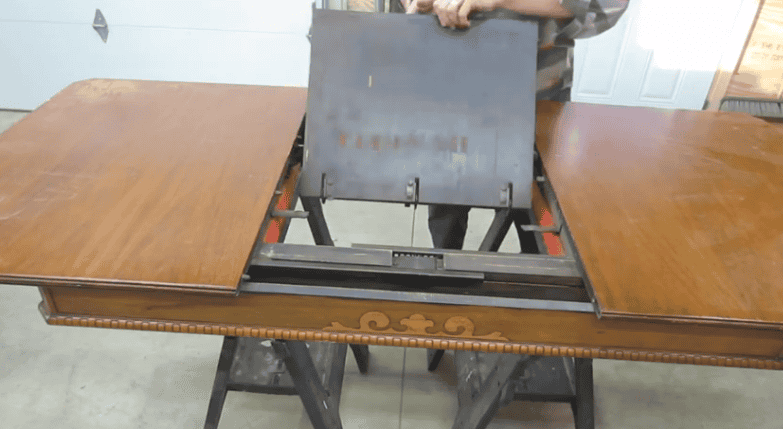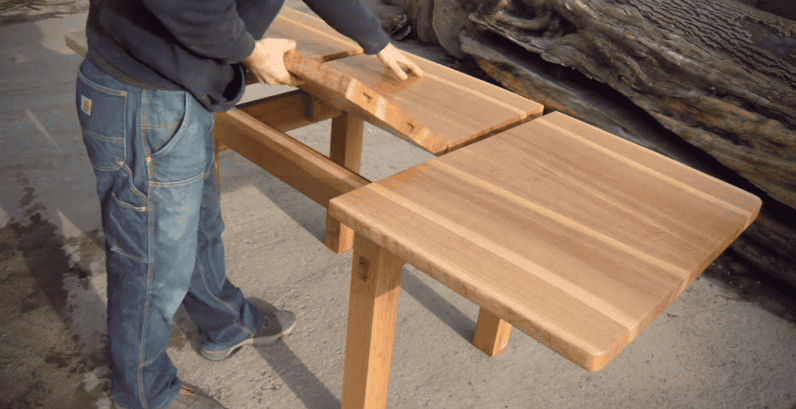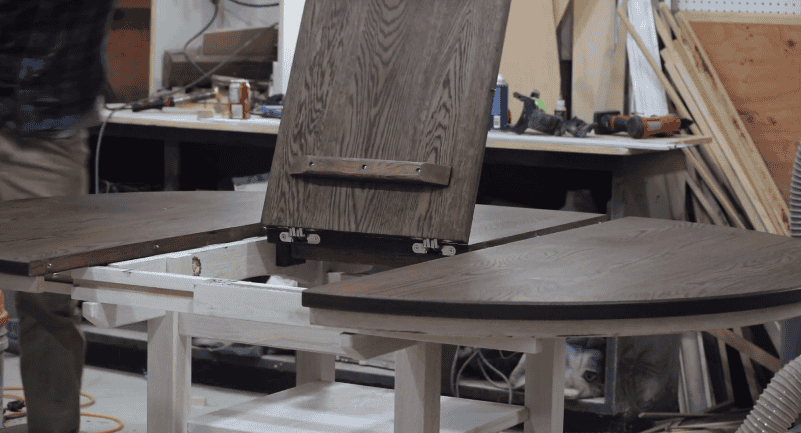Butterfly leaf tables have hidden sections by their sides that open up to provide an extra table surface when needed. This type of table is compact and extensive, allowing you to fold the arms in and out for a wider table surface.
Building a table with a movable surface is new to most DIY enthusiasts, so it might prove challenging without adequate guidance. Depending on the design, the butterfly table leaves can be folded or slid underneath to hide them when not in use. You can accommodate more guests without rearranging furniture with a butterfly leaf table.
As a DIYer, you can customize the butterfly leaf table to your specifications by following any of the free plans listed below. This guide includes several butterfly leaf table ideas with varying designs for DIY enthusiasts to build, depending on skill level.
Tools And Materials Required
Get these supplies ready if you want to make a butterfly leaf table. However, remember that specific dimensions and supplies will vary depending on the chosen design.
Tools
- Table saw
- Circular saw, or jigsaw
- Clamps
- Measuring tape
- Pencil for marking
- Sander
- chisel
- Paint applier (brush or chisel)
- Screwdriver
- Drill
Materials
- Plywood or any quality wood of your choosing
- Stain or paint
- Wood glue
- Wood screws or nails
- Finishing nails
- Hinges and Hardware
- Sealant and wood filler (optional)
- Protective gear (goggles, nose masks, ear muffs, and boots)
DIY Butterfly Leaf Table Plans
If you need help with a butterfly leaf table idea and building instructions, this section will provide several free DIY designs with detailed plans.
Choose the design that suits your needs and follow the plan to replicate the table. You can also combine more than one idea if you seek uniqueness.
1. Oval-Shaped Butterfly Leaf Table

Understanding the basic geometry of this table will simplify its building process. There’s a diagram of the table showing all its parts to make it easy to identify and another diagram of the leaf’s mechanism and apron’s cross-sectional view. All these diagrams make following the guide straightforward.
While this table consists of only a pair of butterfly leaves, multiple pairs can be included for a wide reach. However, you must consider the space under the table for the leaves to swing freely.
The plan showcases the mechanism of the folding leaf and selecting the correct wood type. Solid wood resistant to seasonal issues like warping wood is the most preferred. There’s also a hardware selection process where heavy-duty hinges, hinge pins, and pivot pins are included in the project.
2. Stable Butterfly Leaf Table

While some butterfly leaf tables come with trestle bases that are aesthetically pleasing but not the most stable, this idea uses a more stable four-leg base. The idea is to build a durable table that can carry weight across all parts of its surface without crumbling.
Like most other tables, the leaf here folds underneath the table with just enough room to slide the other table surface over it. This leaf-folding mechanism keeps the area under the table uncluttered.
The video guide starts with an already-built table frame and legs while showing how to build the surface with the leaves. It is vital to measure the center of the table to locate the leaves.
Building the leaf here is straightforward with the right hardware and setup. The wooden fulcrum and steel tube help to keep the leaf from moving off its alignment.
3. Simple Square-Edged Butterfly Leaf

This idea will appeal if you prefer a square edge to an oval or round table. Its butterfly leaf design is similar to many others, where its leaf is safely stored under the table and can be manually opened up when required. The base is a variation of the trestle design, this time offering more balance.
The detailed plan shows how to cut, measure and build the bottom section of this butterfly leaf table before its more technical table surface. The apron sides in this table include the slide mechanisms that make it easy to expand and close the table.
The plan is a long video showing details of all the processes, including the table mockup to prevent errors and its final installation. A table design is also included in the guide for builders looking for more details. You can freely download the plans through a link in the description.
4. Solid Walnut Butterfly Leaf Table

This butterfly leaf table uses solid walnut wood, giving it its dark, husky look. It is just under 6 feet long and extendable an extra 20 inches when you open the leaves. The base is stationary, with only the table surface in motion when manually folding the leaves.
The fulcrum in this table helps the leaves as they open in a slightly unconventional way. The leaves fold on the same level as the surface on the fulcrum and will need to be flipped under it to lower it.
The idea for this plan is to increase the size of the table. So the initial table with a similar mechanism was taken apart. Since the table is small, the builder wanted to adapt the design to build a larger table to accommodate more guests. Follow the video guide to see the complete building process.
5. Handmade Solid Oak Butterfly Leaf Table

Here is a handmade butterfly leaf table design that uses a solid oak wood cut out and planed with a planer to deliver a durable table. The short guide goes through the building procedure, from ripping down the rough planks to finishing. Stains that allow the grains to be visible are preferred.
The different lumber boards are glued together to form a solid tabletop surface. The guide utilizes mortise and tenon joints cut out using a drill and a chisel to attach the table legs.
Each piece is cut, planed using a hand planer, and chamfered for a detailed design. Finishing involves sanding the tabletop using a sander to get a smooth surface. At the same time, other materials like sealant and stains provide shine.
This guide needs to be more detailed and would require prior experience building similar butterfly tables. See the video plan for the available details.
6. Circular White Oak Butterfly Leaf Table

The circular butterfly leaf table is made using white oak. Circular butterfly leaf tables are unique since most designs are rectangular, square, or oval. The white oak lumber surface is stained with a walnut-type finish to produce a deep hue.
It is a short video showing a butterfly leaf’s building process for a circular table. While the full table is up for sale from the builder, you can use this guide to build your table if you have butterfly leaf table-building experience.
Even though the top is circular, its base is a stable four-leg bottom with braces that enhances its stability. Follow the guide for wood preparation steps to get a smooth surface. There are also steps to plane the board using a planer. It uses mortise and tenon joints cut out using a chisel to hold the legs to the frame.
FAQ’s
You may have questions in your mind when building a butterfly table. More so when building the leaf.
We’ve compiled the most popular ones and answered them in this section.
Ans: A butterfly leaf table consists of a center section with two or more hinged leaves that can be folded underneath or extended for a wider surface. The apron is an important part of the table as it houses the sliding mechanism that opens the table to reveal the leaves.
Ans: You can use a variety of materials to build this table; however, it is recommended to use solid wood like oak, pine, and durable plywood for the surface. Hardware like hinges and steel tubes are also used for this table.
Ans: Versatility and space-saving are the primary advantages of making a butterfly leaf table. You save a lot of space as a considerable part of the table is hidden underneath when unused. It is also convenient as you don’t have to move the bottom when extending the table.
Ans: It is possible to add a butterfly leaf mechanism to an existing table; however, the table must also have a similar structure in place. Otherwise, significant modifications must be made, which may be too complex for many DIYers.
Ans: Your needs should guide how you finish the butterfly leaf table surface. Popular finishing choices involve stains, sealant or varnish, and painting. It would help if you stuck to staining to retain the natural look and keep the wood grains visible.
Conclusion
Considering the folding leaf mechanism, building a butterfly leaf table seems daunting. But it gets easier if you understand the procedure. You can incorporate multiple ideas to construct an exciting table design in any shape.
Due to the nature of the butterfly table, good wood-cutting and joining knowledge is required beforehand.
